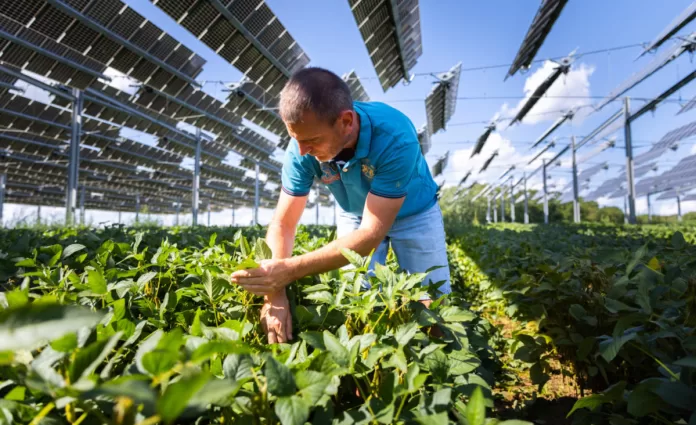Last year, TSE presented its first agrivoltaic field crop demonstration in France. The experimental project is equipped with its “agricultural canopy,” a big canopy with revolving solar panels attached to cables 5 metres above the fields.
In addition to growing soy, wheat, fodder rye, winter barley, and rapeseed, the farm also houses 150 cows. It has seen extremely hot and dry summers over the past decade. TSE erected the PV system to take use of the tree’s shade, as well as the summertime reductions in evaporation and temperature. Annually, the agrivoltaic system generates 3,2 GWh of power.
The French developer has now unveiled the initial findings of the project. Early in June 2022, a three-hectare plot was planted with soybeans. The PV canopy covered the location. Six distinct types of soybeans were planted for the initial experiment, with harvest scheduled for October 12, 2022.
The researchers saw robust vegetative growth, typical blooming, fertilisation, and physiological maturity in the soybeans. The six studied cultivars produced yields that varied by as much as 25% under the canopy and 19% on the control field.
“Despite a strong heterogeneity of the environment and in particular of the soil, the data obtained, particularly for the Soprana variety, indicate extremely promising results for future harvests: no significant difference for the overall yield and number of pods of the soybeans outside and under the canopy, with higher 1000 kernel weight under the canopy,” stated TSE.
In terms of temperatures, the agrivoltaic canopy provided greater protection against thermal stress during heat stroke: the highest temperature observed beneath the canopy is 1.2 degrees Celsius lower than in the control region. From mid-June to mid-August, measurements at a depth of 30 centimetres in the core of the PV system reveal an average temperature of -3.5 degrees Celsius and a higher level of humidity retention.
In addition, the water potential under the canopy was determined to be greater. In contrast to the soybeans under the PV canopy, the soybeans in the control zone experienced water stress throughout blooming and the onset of grain filling.
“As a result of this event, I saw damage to the control area, but the soybeans planted behind the panels were better protected,” explained farmer Sylvain Raison.





